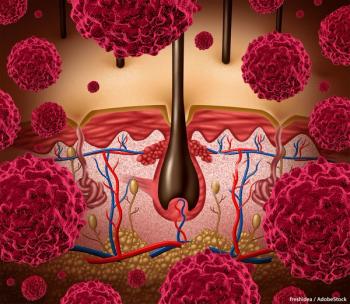
Cutaneous Toxic Effects of Anti–PD-1 Therapy May Signal Improved Response in Melanoma
Researchers looked at the outcomes of patients who experienced cutaneous toxic effects after treatment with anti–PD-1 therapy for advanced melanoma compared with patients who did not.
Patients who experienced cutaneous toxic effects after treatment with anti–programmed death 1 (PD-1) therapy for advanced melanoma had superior outcomes compared with patients who did not, according to a recent study.
These outcomes included superior response rate, progression-free survival, and overall survival (P < .001 for all), and showed superior outcomes for patients with vitiligo and rash compared with pruritis only.
“This observation suggests potentially distinct mechanisms for vitiligo, pruritus, and rash, and is the first to our knowledge to dissect divergent outcomes for these distinct cutaneous manifestations,” wrote researcher Henry T. Quach, BS, of Vanderbilt University School of Medicine, and colleagues, in a
The study included medical records for 318 patients from Vanderbilt University Medical Center diagnosed with advanced melanoma and treated with anti–PD-1 therapy with or without ipilimumab.
Thirty-eight percent of patients enrolled developed cutaneous toxic effects; these patients were more likely to have received combination treatment with ipilimumab and nivolumab and have had prior systemic therapies, including immune or targeted agents.
Patients with cutaneous toxic effects had double the response rate compared with those who did not (60.0% vs 28.6%). Median progression-free survival among patients with cutaneous effects was significantly longer at 797 days compared with 112 days, and median overall survival was 3 times as long, at 1,691 days compared with 526 days.
Multivariable analysis showed cutaneous toxic effects as independently associated with superior response rates (odds ratio, 3.58; 95% CI, 2.17–5.90).
The researchers also examined if the type of cutaneous toxic effects was associated with disease outcomes. Those patients who reported vitiligo or rash had a superior response to therapy compared with those with pruritus only (75.0% vs 64.9% vs 25.0%; P = .009). Differences in progression-free survival and overall survival were also significant.
Finally, data also showed that cutaneous toxic effects that occurred after 3 months on therapy were linked with the best outcomes. Response rates were best for patients with late effects (68.3%) followed by early effects (55.7%), and was worst among patients with no cutaneous toxic effects (28.6%). Similarly, progression-free survival was not reached for patients with cutaneous effects occurring after 3 months, 383 days for patients with early effects, and 112 days for patients with no cutaneous effects (P < .001). Median overall survival has not yet been reached for those with late cutaneous effects, is 1,065 days for early effects, and is about half that-526 days-for patients with no cutaneous effects (P < .001).
Finally, data revealed that administration of steroids had no adverse effects on response rate, progression-free survival, or overall survival.
“This is the first study to our knowledge to demonstrate this finding, highlighting a potentially unavoidable bias of toxicity-response correlations, because patients remaining on therapy have the highest risk of developing toxic effects, but are also the patients who are benefiting from therapy,” the researchers concluded.
Commenting on the study,
“As the authors address, more data will be necessary to draw a conclusion regarding adverse effects associated with oral steroid administration in this patient population,” she said. “They also identify how patients who remain on therapy longer may be more likely to experience cutaneous toxicity. The goal of dermatologists involved in the care of oncology patients should be to mitigate symptoms of cutaneous toxicity to promote treatment adherence.”
Newsletter
Stay up to date on recent advances in the multidisciplinary approach to cancer.





















































































